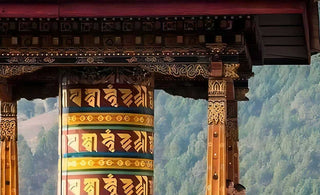
Exploring the Rich Tapestry of Tibetan Buddhist Art
Tibetan Buddhist art stands as an exquisite testament to ancient cultural heritage and spiritual expression. Enriched by centuries of tradition, this art form encapsulates the essence of Tibetan spirituality, history, and beliefs. Embodying a unique blend of symbolism, vibrant colors, and intricate details, Tibetan Buddhist art mesmerizes art enthusiasts and spiritual seekers alike.
The Intricate Symbolism of Tibetan Buddhist Art
Tibetan Buddhist art speaks a visual language, conveying profound spiritual teachings through symbolic representations. Each stroke of paint, every meticulously crafted design, holds deeper meanings, serving as a bridge between the earthly realm and spiritual dimensions. From the compassionate depictions of deities to the intricate mandalas representing cosmic order, these artworks invite viewers into a world steeped in symbolism and significance.
Spiritual Significance and Cultural Heritage
At the heart of Tibetan Buddhist art lies a narrative that transcends mere aesthetics. Every brushstroke, color choice, and intricate detail within these artworks carries symbolic significance, aiming to convey spiritual teachings and concepts. For instance, thangka paintings, meticulously handcrafted on canvas, depict deities, mandalas, and cosmic realms, serving as visual aids for meditation and spiritual contemplation.
The depiction of Buddhas and bodhisattvas in Tibetan art signifies enlightened beings embodying compassion and wisdom. Each deity is adorned with specific attributes and gestures that hold symbolic meanings, offering guidance to practitioners on their spiritual path. The intricate designs within mandalas represent the universe, symbolizing harmony, balance, and the interconnectedness of all things.
Ritualistic and Meditative Practices
Beyond their aesthetic appeal, Tibetan Buddhist art plays a crucial role in religious rituals and meditative practices. Monasteries adorned with intricate murals and sculptures create an environment conducive to spiritual contemplation. Devotees engage in practices such as circumambulation, where they walk clockwise around sacred structures adorned with art, symbolizing the cyclic nature of existence and spiritual growth.
Thangka paintings, often used in rituals and ceremonies, serve as focal points for meditation. Practitioners contemplate these artworks, using them as tools to deepen their understanding of Buddhist philosophy and attain spiritual insights. The process of creating these paintings itself becomes a meditative practice, requiring patience, devotion, and a deep understanding of Buddhist iconography.
Potala Palace: The Epitome of Tibetan Buddhist Artistry
Nestled amidst the picturesque landscape of Lhasa, Tibet, the Potala Palace stands as an enduring testament to the rich cultural heritage and artistic brilliance of Tibetan Buddhism. Perched atop Marpo Ri (Red Hill), this architectural marvel serves as an awe-inspiring beacon of spirituality and historical significance.
Historical Tapestry and Cultural Legacy: The origins of the Potala Palace date back to the 7th century when King Songtsen Gampo commissioned its construction as a tribute to his marriage with Princess Bhrikuti of Nepal and Princess Wencheng of China. Over the centuries, subsequent rulers and the spiritual leadership of the Dalai Lamas expanded and enhanced this magnificent structure, shaping it into the architectural wonder it is today.
Architectural Marvel and Spiritual Center: The Potala Palace stands as a grand manifestation of Tibetan architectural prowess, comprising two main sections – the Red Palace and the White Palace. The Red Palace, with its striking crimson walls, houses numerous chapels, halls, and revered relics, while the White Palace served as the living quarters for the Dalai Lama and administrative offices.Within the walls of the Potala Palace reside some of the most exquisite examples of Tibetan Buddhist artistry. The palace walls are adorned with captivating murals, depicting scenes from Buddhist scriptures, historical events, and celestial realms. Each stroke of paint, meticulously applied by skilled artisans, narrates a story, capturing the essence of Tibetan culture and spirituality.
The Magnificent Murals of Potala Palace
The Tibetan Buddhist art found in the murals of Potala Palace is a visual symphony that transcends time. These intricate artworks are not merely decorative; they serve as conduits for spiritual contemplation and education. The themes portrayed range from the life of Buddha and Bodhisattvas to historical events, offering a visual chronicle of Tibetan history and beliefs.
The vibrant colors used in these murals symbolize various aspects of spirituality and signify the interconnectedness of all life. Intricate details and symbolic representations abound, inviting observers to delve deeper into the rich tapestry of Tibetan Buddhist philosophy.
Preserving Heritage and Cultural Identity
As a UNESCO World Heritage Site, the Potala Palace stands as a testament to the significance of preserving cultural heritage. Efforts in conservation and restoration ensure that these priceless Tibetan Buddhist art treasures endure for future generations, safeguarding the legacy of Tibetan culture and spirituality.
Visitors from around the globe are drawn to the Potala Palace, not only to witness its architectural grandeur but also to immerse themselves in the spiritual ambiance created by its exquisite artworks. The palpable sense of reverence and awe that envelops visitors as they traverse the halls adorned with these mesmerizing murals is a testament to the enduring allure and magnetism of Tibetan Buddhist art.
Oriental Aesthetics
Oriental Aesthetics stands as a beacon for preserving and promoting classical oriental art. Our commitment to excellence in providing professional services for oriental artists, collectors, and enthusiasts sets us apart. We specialize in curating, preserving, and showcasing exquisite oriental arts, connecting admirers with these treasures from the past. With a keen understanding of the cultural significance and aesthetic value of these artworks, we endeavor to enrich the appreciation and understanding of classical oriental art globally.























